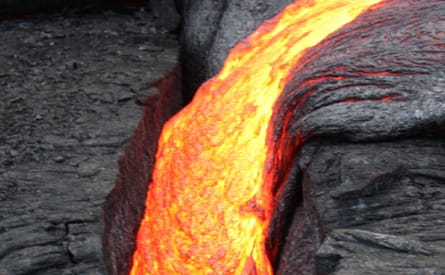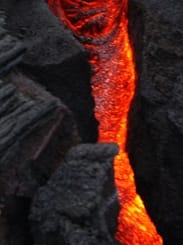
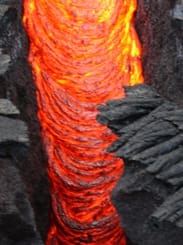
Lava (Arizona Lava)
Proving date: 1994
Proving completed by: Misha Norland and The School of Homeopathy
Common name : Lava
Download: Full proving Lava (Arizona Lava)
Download: Proving rubrics
About Lava
I know what I want and I want it now!
Nothing gets in the way of an active lava flow, and in the Lava patient we will find a forceful disposition. They are assertive, dictatorial and unfeeling. Resistance and obstinacy also feature in the remedy picture along with polar expressions of naive, childlike states in which the individual feels giggly, distracted and excitable. There is calmness, daydreaming and apathy which contrast with a sense of being under attack, scared and agitated. Lava can feel tall, powerful, alert, and focused yet cowardly, unsteady, distracted, and self-despising.
I have always marvelled at the mighty formative forces of our planet. As a youngster of 3 years, my recurring nightmare was of escaping from exploding volcanoes and having to leap over chasms filled with scorching lava. Whenever I drew a picture, it was always of the same scene: volcanic landscapes. Of the various substances that I have had the privilege to prove, this one has been the most personal to my experience.
At the outset I must mention that Lava is by no means my present constitutional remedy, although aged 3, it probably would have been useful. So, here is a piece of my story: I am the second child of European refugee parents and, after a caesarean birth (very traumatic for my mother) I became the object of her devotion and love. In brief, I was over indulged and accustomed to getting my way. I spent my childhood in the peaceful environment of a small fishing village on the Welsh coast. For my parents this was a safe haven from the raging war (the terror of war may well have spilled over into my dream world providing an impulse for my nightmares, although it is of interest that my dreaming imagination called forth, out of the archetypal collective, images of volcanic destruction, hitherto completely unfamiliar to my conscious mind).
After armistice in 1945, I moved with my family to London and at the age of 5 started kindergarten. This was annexed to the top school. During the lunch break of my first day, I ran out of bounds and up to the 'big kids' chemistry labs. I found the teacher and demanded to be shown sulphur. I had expected to be taken into the imaginal world of volcanic eruptions. You may picture my crestfallen disappointment upon being handed a small lump of cold crystalline yellow stuff out of a brown glass jar. 'Is that all?' I was reported to have exclaimed.
I was expelled from my nursery school, aged 7, for unruly behaviour! I was not given to obedience or other 'civilised' traits of a 'good' upbringing. While I had been dubbed a 'bad' child, I retained absolute confidence in myself. It was following that time, after changing schools and being bullied and frightened, that self-doubts crept in. I became increasingly introverted, lonely and secretive. Now that was clearly pathological.
Lava
The layer beneath the Earth's crust is called the mantle. It is the thickest layer and made of semi-molten rock called magma. Geothermic energy currents generated by the immense heat at the Earth's core, cause magma to rise to the surface. Usually at plate boundaries, it is expelled through vents in composite or shield volcanoes. Eruptions associated with the steep-sided composite volcanoes are violent, ejecting thick and sticky, slow-moving lava. Those associated with the wide, gently sloping shield volcanoes are not explosive and lava flow is thin and runny. Lava flow is enormously destructive to anything in its path; it can flow great distances before it cools and solidifies to form igneous rock. Lava commonly takes one of 3 forms – felsic (silicic), intermediate (andesitic) or mafic (basaltic) – and its chemistry correlates with magma temperature, viscosity and eruption.
Silicic and andesitic lava: are associated with composite volcanoes. Silicic lava is created by pyroclastic flows and the collapse of silicic lava domes. The lava is sticky and fragments as the magma is expelled from the volcano. The thickness and stickiness of the lava relates to the silica, aluminium, potassium and calcium content that generates a polymerised liquid. Andesitic lava is lower in aluminium and silica content but richer in magnesium and iron. It is commonly hotter and tends to be less viscous.
Basaltic lava: is abundant due to it being the product of melting mantle, that makes up the majority of the Earth’s volume. Lava flows are associated with shield volcanoes and flood basalt (the outcome of volcanic eruptions that cover vast swathes of land or ocean floor). Basaltic lava is rich in iron and magnesium, and low in silica and aluminium, reducing the degree of polymerisation within the melt. It forms boninite rock. Due to its temperatures, viscosities are low (the viscosity of lava is vital as it determines how lava will behave). This low degree of polymerisation and high temperature favours a chemical diffusion, making it common to see well-formed large phenocrysts within basaltic lava. Basalt, a grey to black extrusive igneous rock, is formed from rapid cooling of basaltic lava.
Mythology
Vulcan: The word 'volcano' derives from Vulcan, the Roman god of fire, metalworking and the forge. The Romans worshipped Vulcan seeing fire as destructive and the male principle in life. In Roman legends, he is the father; a primordial being or king who is later transformed into a monster that resided at the Aventine Hill in Rome. His power was immense, and shrines to Vulcan were situated outside the boundaries of Rome for protection from fire and enemies. Sacrifices were made to save crops from fire. The Vulcanalia, an annual festival, was held to honour Vulcan and his association with earthquakes, fires and volcanic eruptions. During 64 ad, the great fire of Rome occurred and it was believed Vulcan needed to be placated, so larger sacrifices were made to the god during Vulcanalia each year thereafter. Despite the sacrifices, the day after the festival on 23 August 79 ad, Mount Vesuvius erupted destroying Pompeii and Herculaneum. Varro, an ancient Roman scholar and writer, recounted the story of fish being offered alive on an altar to Vulcan in place of human sacrifices. He wrote that from fire there is birth and heat, and that he who dies loses the fire and becomes cold; from the fire's force and violence, Vulcan was named.
Pele: is the Hawaiian goddess of the volcano. She was set to become the water goddess but developed a love of fire and accidentally set her home ablaze. Her older sister Namaka, the Hawaiian goddess of the sea, threatened to create a flood to punish Pele but fearful for their safety from the powerful ocean waves, they journeyed by canoe to Mauna Loa Island with the tallest mountain on Earth. Pele kept her fires lit, which angered Namuka and a ferocious battle ensued. The fires rose from the trembling Earth, sending rivers of lava into the ocean which, on cooling, created a landmass – the island of Hawaii. Pele did not survive her viscous attack and was transformed into a spirit, taking up residence inside her volcanoes.
Astrological: Aries, the first sign of the zodiac, like the volcano, is impatient, spontaneous, eruptive with bursts of excitement or aggression, and has the force of innovative drive and power. A transit through Aries in an astrological chart often marks the start of an intense and turbulent period.
History
Culture: The word 'lava' derives from the Latin word ‘labes’ which means to fall or slide. In 1747, Francesco Serao published Vesuvius, Eruption of, in which he wrote an account about the eruption of Vesuvius. He dismissed the suggestion that Vesuvius had erupted because a god was displeased and was first to use the word lava. In his work, he described ‘a flow of fiery lava’ triggered by a chemical reaction of minerals that proved highly flammable.
Outer space: Dark areas on the Earth’s moon are the plains of flood basaltic lava flows. Samples were taken by the American Apollo Program in the 1960s and 1970s. Most of the lava on Lo, the 3rd largest moon of Jupiter, is basaltic. Mercury, Mars and possibly Venus also show indications of volcanic activity with basalt covering vast areas of the planets.
Metamorphic belts: Study of basalt in these belts provides detail about mineralogical composition and structure. Mineral content and the texture of rocks vary according to heat and pressure, and indicate the site of ancient subduction zone margins, useful in determining tectonic activity.
Clinker: Basaltic lava is characterised by a rough or rubbly surface that is composed of broken lava blocks called ‘clinker’, originally a Hawaiian word.
Emily Dickinson: uses the image of Mount Vesuvius to symbolise volatile human inner turmoil. The powerful imagery evokes suggestions of suppression, depression, violence and seismic outbursts; scorching passion and lips that part, releasing a burning flood of female sexuality.
A still—Volcano—Life*
A still—Volcano—Life—
That flickered in the night—
When it was dark enough to do
Without erasing sight—
A quiet—Earthquake Style—
Too subtle to suspect
By natures this side Naples—
The North cannot detect
The Solemn—Torrid—Symbol—
The lips that never lie—
Whose hissing Corals part—and shut—
And Cities—ooze away—
*Emily Dickinson, A still—Volcano—Life (1863)
Uses: Basalt is commonly used as an aggregate for road bases, concrete, railroad ballast, etc. Basalt rock dust delivers nutrients to plants and is a valuable fertiliser. Basalt felt, provides low thermal conductivity, fire and heat protection (withstand-ing temperatures up to 982° C), and high sound absorption for noise reduction. In order to tackle global warming, new technologies of carbon sequestration are being developed to capture and store carbon dioxide. The gas is naturally utilised and transformed into sugars and cellulose by plants but with increased levels of atmospheric CO2, one possibility of reducing CO2 levels, is to store safely the gas long-term in subsurface rocks, such as basalt. Since 2014, the Hellisheidi power station, a geothermal plant in Iceland, has been experimenting with collecting atmospheric CO2 from steam, which is dissolved into vast volumes of water that is then piped beneath the ground. Here, the solution fills large pores in the basalt and within months, chemical reactions solidify the liquid into white, chalky calcites, preventing the release of CO2 into the atmosphere for millions of years.
The proving
The substance used in the proving was a piece of basaltic lava brought from Sunset Crater near Flagstaff, Arizona.
Lava is a simple remedy – the primary state of Lava is flowing and going – going for it no matter what – nothing gets in the way of an active lava flow. This is a childlike state which, if found in an adult, would be viewed as their characteristic forceful predisposition. The compensated secondary state of Lava is hardness (like the crust of cooling lava), resistance and obstinacy. Both primary and secondary states may be viewed as unfeeling; the behaviour as callous and amoral. The decompensated state is not apparent in the proving, yet one might expect characteristic psychological components to be aridity, barrenness and isolation. The Lava individual is either awake or burnt out; active, heated and indifferent or passive, cool and unmoved. There is obviously a continuum of tendencies between the states of action and reaction, for instance, the primary state of flowing and going, has its polar aspect of agitated unsteadiness and unsureness. Dictatorial and quarrelsome tendencies find their opposite expression in content childlike states and feelings of being under attack, forced against one's will, and of neglected duty. One prover wrote, 'I won't work for somebody as arrogant or egotistical as he is. If he becomes office manager, I'm leaving – I don't have a problem calling a spade a spade. I don't care if my feelings are right or wrong or if I'm stupid or not'. Other Lava symptoms of feeling tall, powerful, assertive, alert, clear and active are contrasted with falling, lacking focus, daydreaming, feeling stoned, distracted, self-despising and cowardice – 'Nothing seems important. I don't give a f*** about things at the moment. I just want to drift on carefree, not a bother in the world'.
In contra-distinction to the relentless confidence of the primary state, there is a sub-theme of twoness in the remedy. One prover dreamed of 2 paths and, in another dream, of 2 persons running on a cliff path, one of whom, despite the danger said, 'I'm going that way anyway!' and fell over the cliff edge. The 'I'm going that way anyway!' aspect, which was experienced by another prover who found herself singing, 'I know what I want and I want it now', is characteristic of the unfeeling, disconnected nature of Lava. This sense of indifference can give rise to others disliking and being critical of that state. The supervisor of prover 10 wrote, 'She is arrogant, unfeeling, dictatorial. Totally disinterested in anything anybody has to say except herself. I hate being around her – it's a horrible state – repulsive! People say what would be hurtful things to her – she doesn't care. If anyone crosses her, she just goes for them, otherwise she doesn't bother to talk.' In essence, Lava is a simple remedy; it is primal, basic. This is unsurprising when bearing in mind it originated in primordial times and played a considerable role in the evolution of our planet.
Download: Full proving Lava (Arizona Lava)
Download: Proving rubrics
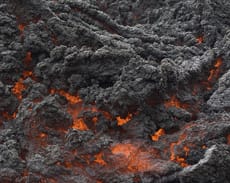
Assertive - Feeling stoned - Confused - Daydreaming - Burnt out - Disconnected - Awake - Agitated - Content
Proving Themes
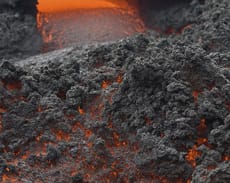
Kingdom Taxonomy
The Goddess Pele is the Hawaiian Goddess of the Volcano, she was meant to grow to become the water goddess, but after discovering matches her fascination for fire took her in a new direction. After ignoring her mothers' instructions she managed to set her home a light while playing with fire from the underworld.

.jpg)
